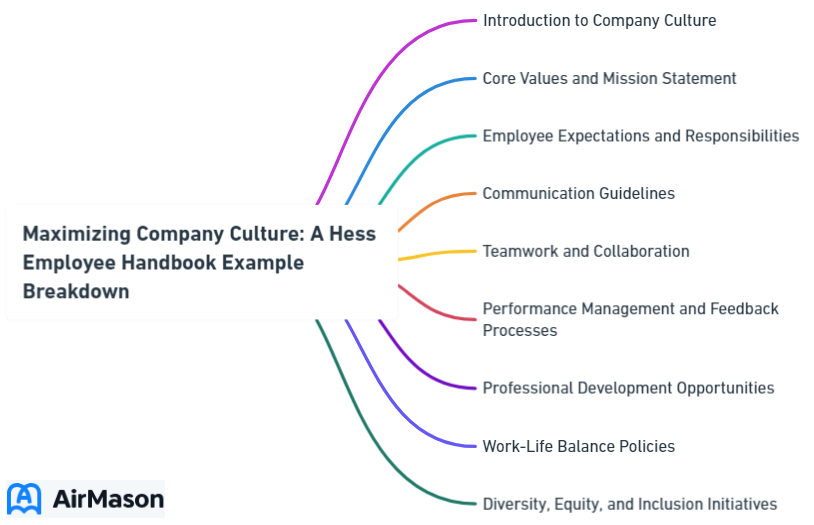
Examine the Hess employee handbook example to align your team with core company values and operations. This article dissects the key components that make Hess Corporation’s handbook effective, from embedding core values to instilling a culture of ownership and social responsibility, setting a clear expectation for those wanting to craft their organization’s manual.
Key Takeaways
- Hess Corporation’s employee handbook emphasizes six core values (integrity, people, performance, value creation, social responsibility, independent spirit) to guide employees’ behavior and performance, align their actions with the company’s mission, and build a strong corporate culture.
- The handbook outlines Hess Corporation’s commitment to social responsibility and environmental sustainability, detailing measures to reduce emissions and encouraging employees to contribute to these initiatives for future generations.
- An effective employee handbook should include clear company policies, ensure legal compliance, focus on workplace safety, and detail employee benefits and compensation, all of which are principles reflected in Hess Corporation’s handbook.
Fortune 500 Companies Employee Handbook
Welcome to our esteemed Fortune 500 company! This employee handbook serves as a comprehensive guide to navigate your journey within our organization. The “Fortune 500 Companies Employee Handbook” is designed to provide you with valuable insights into our corporate culture, policies, and expectations. As you embark on this exciting professional adventure, familiarize yourself with the contents of this handbook, ensuring a smooth integration into our dynamic workplace. Your success and satisfaction are paramount, and this handbook is a key resource to help you thrive in your role.
Hess Corporation’s Approach to Employee Handbooks
Hess Corporation, a leading global independent energy company, navigates the complexities of employee engagement with a robust, value-driven approach. Their employee handbooks act as a compass, guiding team members through the company’s core values, social responsibility initiatives, and strategies for fostering a positive work environment.
Emphasizing Core Values
At the heart of Hess Corporation’s handbook lie six core values:
- Integrity
- People
- Performance
- Value Creation
- Social Responsibility
- Independent Spirit
These values are not just words on a page; they are the pillars that uphold the company’s reputation in the stock market and the guiding principles that shape everyday operations, as the company expects.
Highlighting these values in the handbook aids in keeping employees synchronized with the company’s mission and vision. The effect is far-reaching – it instills a culture of ownership, enabling team members to spot and alleviate potential risks. This emphasis also strengthens community ties, uniting employees under mutual beliefs and objectives.
By embedding these values deeply into their handbook, Hess Corporation has effectively crafted a blueprint for employee conduct and performance. This approach doesn’t just maintain the company’s reputation; it also continually enhances it, demonstrating the power of a value-driven handbook.

Social Responsibility and Environmental Impact
The Hess Corporation handbook also shines a spotlight on the company’s commitment to social responsibility and reducing environmental impact. It’s a testament to the company’s dedication to future generations, outlining the steps they’re taking to contribute to a sustainable future.
Hess Corporation’s stance on social responsibility is intricately interlaced with their company culture. They underscore its significance as a fundamental value in their handbook, equipping employees with a code of conduct that steers and bolsters their dedication to social responsibility. Employees are encouraged to demonstrate sound judgment in their actions and decisions, fostering a sense of ownership that transcends their routine tasks.
The handbook also outlines Hess Corporation’s environmental efforts, from reducing greenhouse gas emissions to setting ambitious targets for the reduction of both greenhouse gas and methane emissions. This pledge, mirrored in the handbook, guarantees that employees comprehend their pivotal role in these initiatives, accentuating the significance of their contributions to the company’s image and the planet’s future.
Creating a Positive Work Environment
A positive work environment is vital for employee satisfaction and productivity, and Hess Corporation’s employee handbook plays a critical role in fostering such an environment. The handbook outlines clear expectations, policies, and resources, setting the stage for a workplace culture that encourages growth, collaboration, and mutual respect.
Incorporating a conflict mitigation section in the handbook, for instance, communicates the company’s code of conduct and the repercussions of inappropriate behavior. This clarity helps maintain a favorable work environment, ensuring that all employees understand what is expected of them and the standards they need to uphold.
Additionally, the handbook amplifies resources for employee well-being, ranging from safety initiatives to wellness event updates on food and fitness. By providing these resources, Hess Corporation ensures ongoing enhancement of employees’ well-being, further reinforcing their commitment to creating a positive work environment.
Key Elements of an Effective Employee Handbook

Although each company’s handbook will mirror its distinct culture and values, there are particular key components that every successful handbook should encompass. These include:
- Comprehensive company policies
- Information regarding legal compliance
- A focus on workplace safety and health
- Detailed sections on employee benefits and compensation
Company Policy and Legal Compliance
One of the primary functions of an employee handbook is to communicate the company’s policies and legal obligations clearly. Grasping these aspects is paramount for employees, as it lays the groundwork for their rights and duties within the company.
For instance, typical instances of legal compliance information frequently found in employee handbooks encompass:
- Equal Opportunity Employment policies
- Non-Harassment and Non-Discrimination policies
- Employment at-will policy
- Compliance with federal, state, and local laws
Hess Corporation takes this a step further by ensuring that community investment programs comply with U.S. and local laws, as well as relevant company policies.
Continuous monitoring for any novel laws or regulations that require handbook revisions is also pivotal. This vigilance ensures compliance with laws and regulations pertaining to:
- Minimum wage
- Overtime requirements
- Anti-discrimination and harassment policies
- Family and medical leave
- Safety and health
- Time off and paid leave
- Social media and technology use
Workplace Safety and Health
A safe and healthy work environment is fundamental to employee satisfaction and productivity. Hence, it’s vital that the employee handbook includes comprehensive sections on workplace safety and health. This includes policies on:
- Confidentiality
- Occupational health & safety
- Harassment & substances
- Conducting work in a safe and efficient manner
- Implementing effective policies and procedures
- Providing training and education
- Identifying potential risks and hazards
- Fostering management leadership and worker participation.
Hess Corporation, for instance, has prioritized fostering a culture of ownership in occupational safety. They have achieved this by:
- Empowering employees to recognize and address potential risks
- Mandating personal accountability for both individual and collective safety among all staff members
- Ensuring compliance with regulatory standards, including those set forth by the U.S. Occupational Safety and Health Administration
- Striving for zero incidents
Through these efforts, Hess Corporation has created a strong safety culture within their organization.
DaVita Employee Handbook Example
In the DaVita employee handbook example, the company demonstrates its commitment to fostering a positive and inclusive workplace environment. The DaVita employee handbook serves as a comprehensive guide, outlining the company’s policies, expectations, and values. Employees can refer to this handbook for information on benefits, code of conduct, and various workplace guidelines. DaVita’s emphasis on transparency and clear communication is evident in the detailed and accessible format of their employee handbook. By providing a robust framework, the DaVita employee handbook exemplifies the organization’s dedication to promoting a culture of understanding, collaboration, and professional growth.
Employee Benefits and Compensation
Transparency about employee benefits and compensation is another key element of a well-crafted employee handbook. It’s essential to outline this information in a clear and comprehensive manner, managing employee expectations and promoting transparency.
Work hours, pay grade structure, timekeeping, overtime, rest periods, stock options (if offered), and the appraisal process are some of the aspects that should be included when outlining compensation information. On the benefits side, the handbook should address:
- insurance
- wellness programs
- company-issued equipment
- equal employment opportunity responsibilities
- policies regarding harassment, drugs, and alcohol
Moreover, laws related to pay transparency mandate that employers must provide information about employee compensation, either to the employees or to the public. Certain states have distinct regulations that necessitate the disclosure of salary ranges to employees, further underscoring the importance of this transparency.
Customizing Your Employee Handbook
While there are essential elements that every impactful employee handbook should incorporate, it’s equally vital to personalize your handbook to represent your company’s unique character. This customization involves considering industry-specific requirements and consulting with legal and HR experts to ensure compliance and effectiveness.
Reflecting Your Company’s Personality

Your company’s identity distinguishes you from your competitors. It’s the unique blend of culture, values, and norms that make your company unique. Reflecting this personality in your employee handbook is crucial for ensuring that the handbook is tailored to your company’s distinct character.
Potential strategies to convey a company’s personality through an employee handbook include:
- Using clear and amiable language that mirrors the company’s voice
- Establishing the company’s brand identity
- Effectively communicating the distinctiveness of the business and its objectives.
Furthermore, merging the company’s brand with the employee handbook can boost brand acknowledgment and foster a profound understanding of the company’s values and goals among employees. Some benefits of merging the company’s brand with the employee handbook include:
- Boosting brand acknowledgment
- Fostering a feeling of affiliation and dedication among employees
- Creating a sense of unity and alignment with the company’s culture and branding
Selecting visuals that are in line with the company’s culture and branding can further enhance the positive impact of these benefits.
Industry-Specific Considerations
Every industry has its unique set of regulations and requirements. When developing your employee handbook, it’s essential to consider these industry-specific requirements to ensure adherence and applicability within your peculiar operational context.
For instance, a technology company may need to include policies on intellectual property protection, data security protocols, and software development processes. A healthcare organization, on the other hand, might need to include guidance on dress code, attendance, and confidentiality.
Identifying and integrating these requirements into your handbook ensures that your handbook remains relevant and effective within your specific industry. It also ensures that your employees have a clear understanding of the unique challenges and intricacies of your industry, allowing them to perform their roles more effectively.
Consultation with Legal and HR Experts
Seeking advice from legal and HR experts while creating your employee handbook is an integral part of the personalization process. These experts can help ensure compliance with laws and the effectiveness of addressing HR policies and procedures in the handbook.
HR experts can contribute to the development of an effective employee handbook by conducting a needs assessment to gather valuable information that will guide them in creating a comprehensive and tailored HR policies and procedures manual.
Legal experts, on the other hand, can help ensure that your employee handbook complies with all relevant employment laws. This includes laws pertaining to:
- minimum wage
- overtime requirements
- anti-discrimination and harassment policies
- family and medical leave
- safety and health
- time off and paid leave
- social media and technology use.
Best Practices for Implementing and Updating Employee Handbooks
While crafting an efficient and tailored employee handbook is vital, it’s also necessary to adhere to best practices regarding the implementation and revision of your handbook. This includes:
- Ensuring digital accessibility
- Regular updates
- Employee training
- Periodic reviews
Digital Accessibility and Regular Updates

In today’s digital age, making your employee handbook digitally accessible is a must. Digital handbooks are not only more convenient and cost-effective, but they also ensure adherence to ADA regulations for accessibility to visually and hearing-impaired individuals.
The digital format also makes it easier to update the handbook to reflect changes in company policies, employment law, and the latest regulations and technologies. It’s recommended to update an employee handbook at least annually to ensure accuracy and compliance.
Incorporating pertinent policies like COVID-19 guidelines and remote work strategies is also pivotal. These policies ensure that employees understand the company’s approach to the pandemic and remote work, helping them adapt to the changing work environment.
Employee Training and Acknowledgment
Upon completion of your employee handbook, it’s important to guarantee that your employees are well-versed with its contents. This includes conducting training sessions or workshops to thoroughly explain the handbook and emphasizing crucial changes and their implications.
It’s also important to ensure that employees have read and understood the handbook. This can be achieved by:
- Making the content interesting
- Demonstrating its value
- Ensuring easy accessibility
- Effectively communicating the handbook’s importance to motivate engagement.
Finally, acquiring employee affirmation of the handbook is vital. This can be done through signed forms confirming their understanding and agreement to comply with the policies outlined in the handbook.
Periodic Reviews and Feedback
Regular reviews and feedback hold a key role in maintaining the relevance and currentness of your employee handbook. It’s recommended to conduct these reviews every one to two years to incorporate the latest organizational policies, legal changes, and societal shifts.
These reviews also provide an opportunity to gather feedback from employees. Establishing a system for employee recognition and grievance resolution, and conducting focus groups with a representative sample of employees can help gather valuable feedback that can be used to improve the handbook. Exercising good judgment in incorporating this feedback is essential for creating a comprehensive and effective handbook.
Ultimately, the goal of these periodic reviews is to ensure that your employee handbook continues to serve as a valuable resource for your employees, helping them navigate their roles effectively and contributing to a positive and productive work environment.
Fidelity National Financial Employee Handbook Example
In the Fidelity National Financial employee handbook example, employees gain valuable insights into the company’s policies, procedures, and expectations. This comprehensive document serves as a guide for navigating workplace dynamics, outlining key principles that shape the organizational culture. By referring to the Fidelity National Financial employee handbook example, individuals can better understand the company’s commitment to fostering a positive work environment and promoting a culture of integrity. The handbook not only addresses day-to-day operations but also emphasizes the importance of compliance with industry regulations, ensuring a harmonious and productive workplace for all team members.
Summary
In conclusion, a well-crafted employee handbook is an invaluable resource for any organization. It sets clear expectations, aligns employees with the company’s mission and values, and fosters a positive work environment. By customizing the handbook to reflect the company’s unique personality and industry-specific requirements, and by following best practices for implementation and updates, companies can ensure that their handbook remains a relevant and effective tool for their employees.
Frequently Asked Questions
Why are core values important in an employee handbook?
Core values in an employee handbook are important because they align employees with the company’s mission and vision, fostering a culture of ownership and empowering employees to identify and mitigate potential risks.
What are the key elements of an effective employee handbook?
The key elements of an effective employee handbook include company policies, legal compliance, workplace safety and health, and employee benefits and compensation.
How can an employee handbook reflect the company’s personality?
An employee handbook can reflect the company’s personality by incorporating language, images, and content that align with the brand identity, norms, and culture of the organization. This ensures a consistent representation of the company’s personality.
What are the benefits of making an employee handbook digitally accessible?
Making an employee handbook digitally accessible offers convenience, cost-effectiveness, and improved accessibility for visually and hearing-impaired individuals. It also allows for easier updates, making it a practical choice for modern organizations.
How often should an employee handbook be updated?
You should update an employee handbook at least annually to stay compliant with changing employment laws and regulations
Important Disclaimer:
The article presented here does not serve as a representation of the company’s actual employee handbook mentioned in this article.
Our discussions and insights regarding employee handbook are based on assumptions about what may be considered significant in the companies’ policies. These assumptions are drawn from available information and industry knowledge. Readers are advised that the content provided is for informational purposes only and should not be construed as an exact reflection of any company’s official policies or procedures. For precise and accurate details regarding a company’s employee handbook, individuals should refer directly to the company’s official documentation or consult with appropriate representatives.
Please be aware that the content on this page has been generated by using artificial intelligence language models and may contain errors, inconsistencies, or outdated information. It is provided as-is without any warranties or guarantees of accuracy. We strongly recommend using this content as a starting point for further research. We disclaim any liability for damages or losses resulting from the use or reliance on this content.